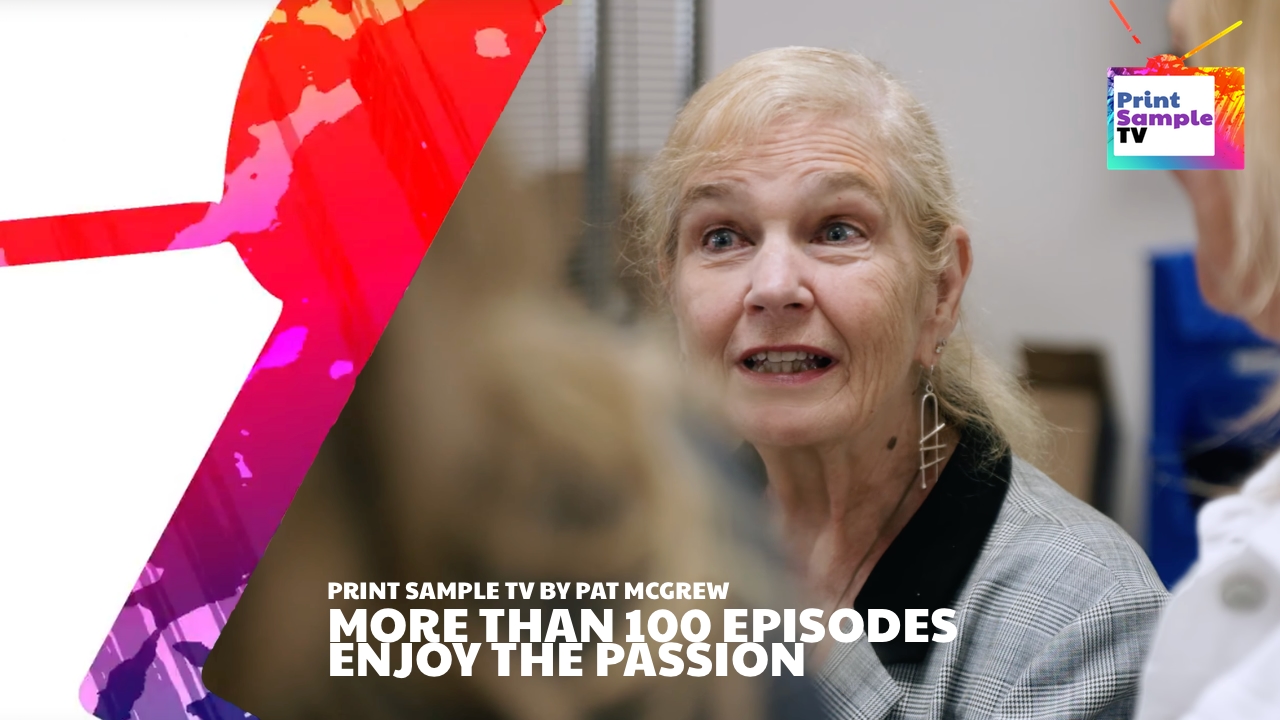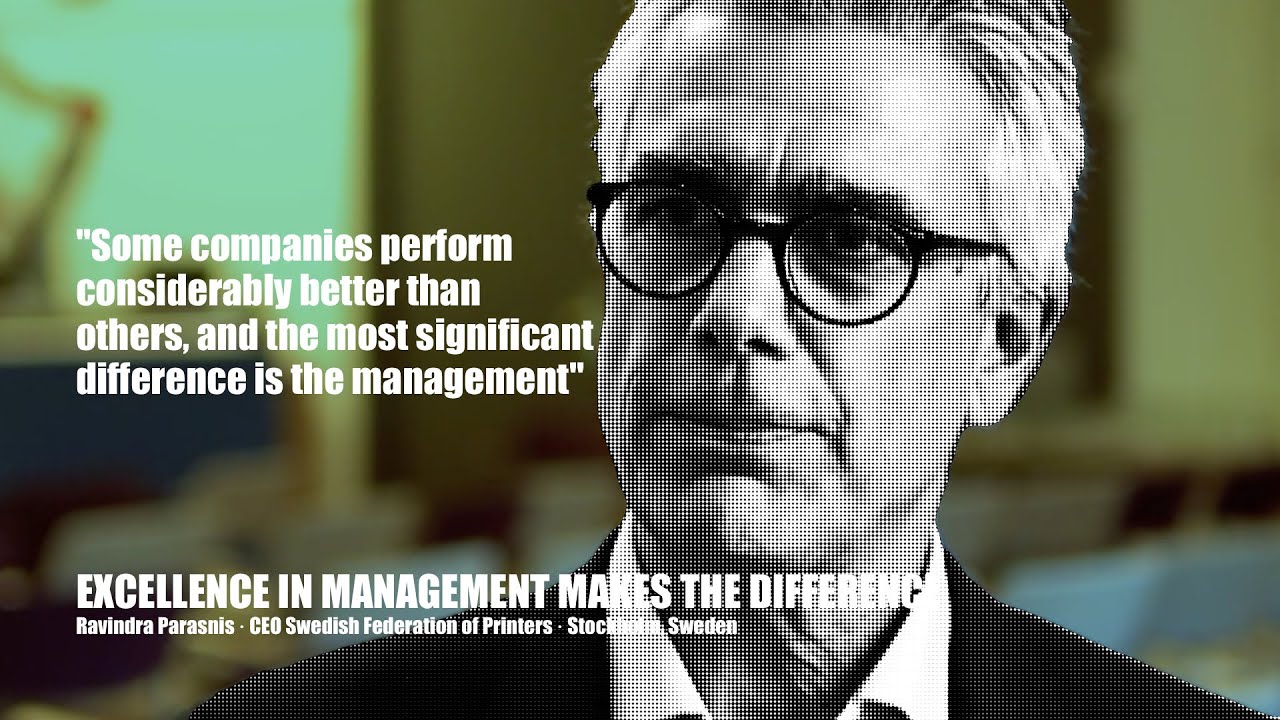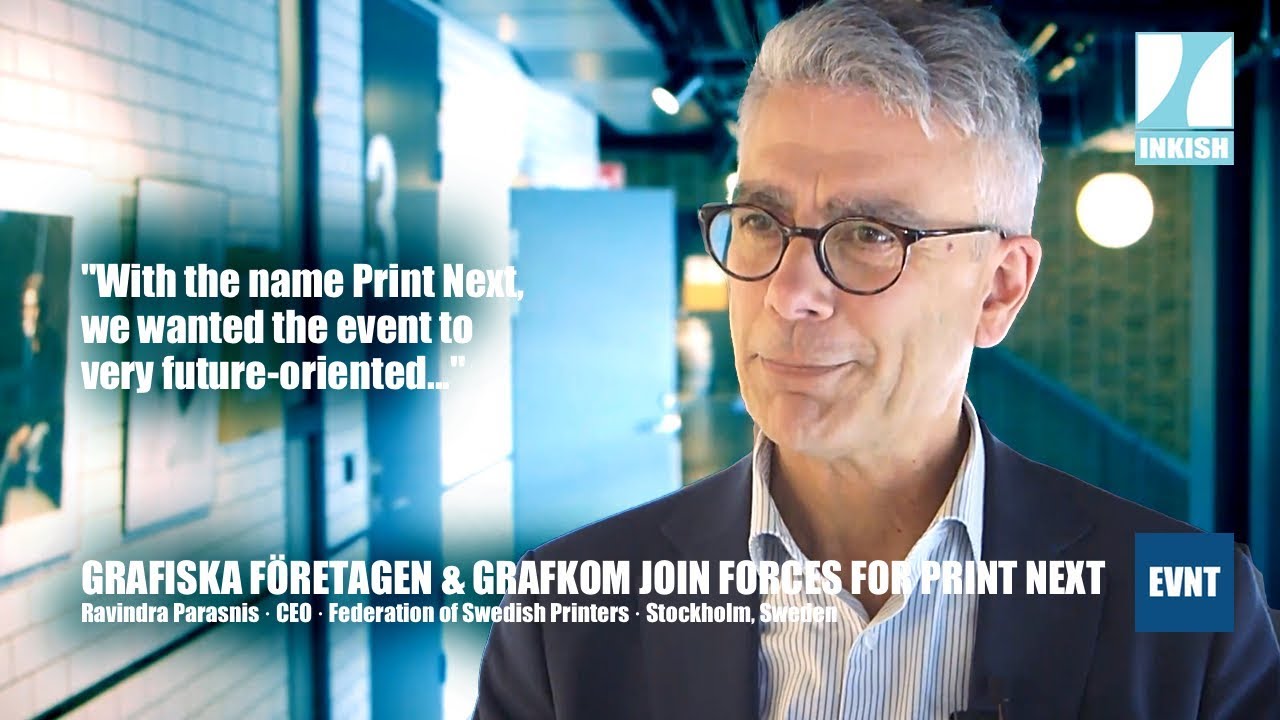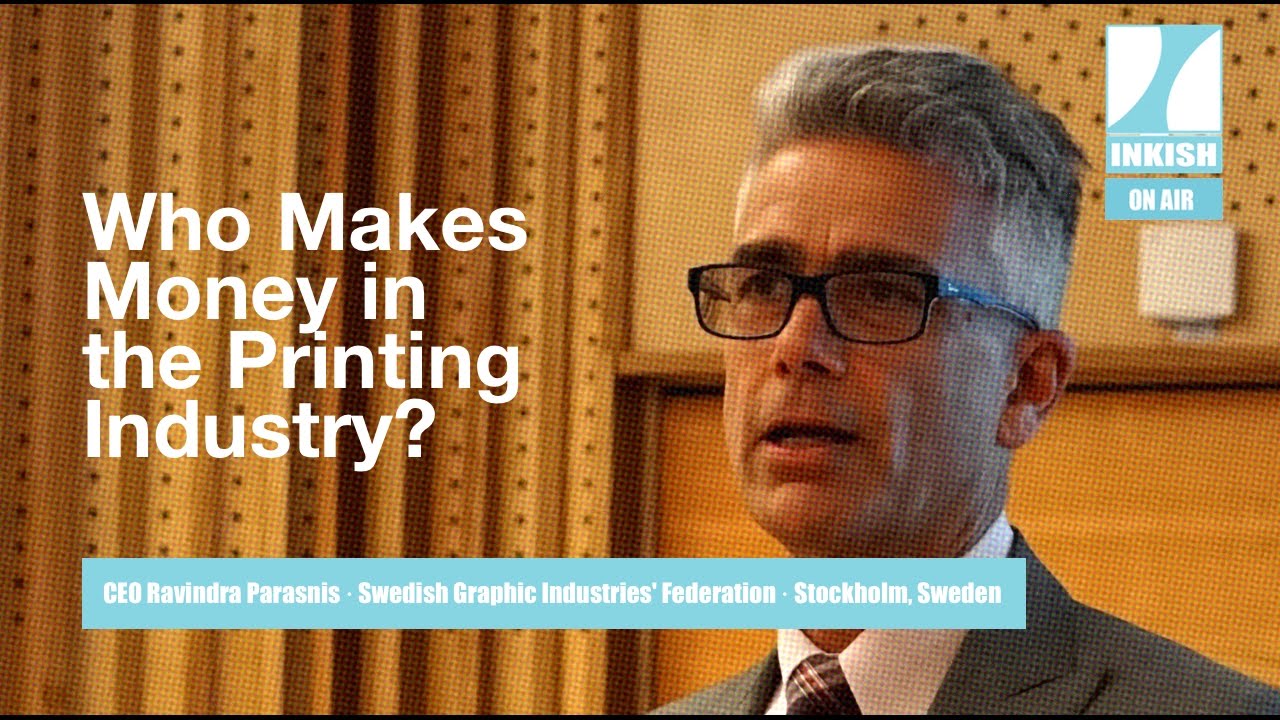Excellence in Management Makes the Difference · Ravindra Parasnis · CEO · Sweden
The Federation of Swedish Printers – Grafiska Företagen, has updated a report that in our opinion, is a valuable tool to understand the printing industry. Based on surveys among 2.000 companies over seven years, and comprehensive analysis work from Bisnode turned out a figure where you could easily see who in the printing industry makes money.
Now, this report has been updated, and there are differences from the first one. Where Large Format was one of the most profitable segments, and even though Large Format is still a precious segment, the trends are unfortunately developing in the wrong direction.
Enjoy the conversation editor Morten Reitoft has with CEO Ravindra Parasnis.
Ravindra, we are here at Print Next 19 in Stockholm, and you have been working together with Grafkom team to make this event happen. Nice to meet you again.
Thank you. Thanks for having me. Nice for having me.
Ravindra, a few years ago we did one of my favorite films. I know that I have quoted this several times. I know that I have also told you that … I actually refer to it quite often, because you made this amazing research which was a major research on who actually makes money in the printing industry. I remember last year when I spoke to you, I asked you if you had any plans of updating it, and that is exactly what has happened now.
Yeah, and maybe it was thanks to your question.
No, but really. We do this on a regular basis, and that’s really to look at the big trends over time, what is really happening in the printing and the graphic industry, and also to see it in relation to what happens in the outside world. Also to have more fact-based discussion around “Where is the industry really going?”
I hope that … Because this is really … The point of this is to inspire or to give food of thought for our members, that they can have some … Some of this is in their strategic agenda, think about where do they want to go. Can they make decisions themselves based on what they see as larger trends? That’s all.
Just to remind our audience in case they can’t remember, because I think that one of the things that was really an inspiration for me was that you together with Bisnode kind of invented a model where you actually compare different sizes of companies with different industries called the SimpleIndex, and as far as I remember, the SimpleIndex is a relation between capital investment, labor investment, and equipment … That’s the capital investment basically. That is the relationship, right?
Yes, you could say so, but let me be [inaudible 00:02:24]. We did not invent the SimpleIndex. It is a model that is used by Bisnode to analyze large numbers of data.
But it was the first time it was used in our industry, right?
Oh, absolutely. Absolutely, because I ran across them at some other point, and-
And what does that index indicate?
The index as such, it’s a relative competitiveness index, you can say. You can measure either an industry, a segment of an industry, you could look at all companies in a region or you could look at individual companies. Then you can relate to what is your relative competitiveness compared with, as in this case, we compared with it the sum of all Swedish businesses. Are you more or less competitive than the average of all Swedish businesses? And what it really tells you, in a way, is that if you’re using capital or personnel in the most effective way, and if you are doing it, if you are having returns that are higher than your competitors, for instance, that means that you will have the resources … You generate returns that means that you can make decisions about your future investment decisions, growth decisions. You are in a better position to decide your own future.
The reason why we as an industry could be interested in knowing who makes money is because we can learn a lot from, because one of the graphs you showed today was the same graph as we showed in the film based on your research, was you have an x-axis and a y-axis, and you have four corners that indicates the relative competitiveness [compares 00:04:25] to value creation, right?
Yeah.
I think that every time you look at it, it must be kind of depressing also for us to be in this industry, because the traditional commercial printers that has been the existence for Grafiska Företagen and is a foundation for Inkish and for all of us, basically, is one of the industries that has a relative high competitiveness but they are not able to make money or grow, right?
No, and that short-term you can be on a side where you create value by really taking down your costs. That is one way of creating value, and that puts you also in a situation over time to make decisions about your future.
But long-term, and that is if we take the whole graphic industry, it is a little bit worrying that when we looked at this last time over the period 2008 to 2014, the graphic industry was shrinking but making relatively good money. Meaning that if we’re talking from an industry point of level, of course you always have to look at the individual company, but looking at … As an industry, the industry had generated money so you can actually make decisions about where you want to go. When we look at this a number of years later and measure the period 2012 to 2017, we see that when we compare to other sectors, other sectors have grown tremendously in the booming economy of Sweden whereas the graphic sector is still in that position of making money by taking out costs rather than growing.
That is like … When we spoke to … Was that his name? Peter [Finiman 00:06:10]? From Bisnode? Was that his name?
Jan Finnemand
Yeah, Jan Finnemand. Because he was like … When we spoke about it, he says that “I’m still the generation that read newspapers. I’m still consuming papers,” because we also at this event today got a speech from Peter Berg talking about the paper and pulp [inaudible 00:06:28] the future of paper. I think that everything that we’re talking about in these relations is not only about how we can take market shares from each other, how we can decrease our costs, how we can … But it’s also how can we turn us into an industry that is more innovative and finding new ways and ideas to produce things, right?
Yeah.
Do you concur on that agenda?
On an individual level, and that’s what I try to show, that even in a mature or declining market, you can have growth strategies. As an individual company you can absolutely have growth strategies, which I [crosstalk 00:07:03]-
Within every segment, basically, right?
In every segment, there will be somebody gro … There are segments in the graphic industry that are clearly growing. Among others, large formats, along with-
Though it’s growing slower than it used to.
Yes, but it’s still growing, maybe because of a bit of maturity. A lot of printers have entered that segment, meaning that because more competitive, the returns in that segment is about average as Swedish businesses in general.
What I think is interesting is that looking at our largest printers, they have really chosen a very clear path of acquisitions. They buy market shares. They consolidate the market. Which is very healthy in a slightly mature and declining market. And we could clearly show that when we look over a longer period of time, that the big printers have created a lot of value and they have also, in terms of size they are much bigger than what they were.
Would you say that they are better off now regardless of the industry trends, just because of the size?
You’re never better off just because of size, but in a declining or a mature market, size is really, really important if you have a sustainable profit, because eventually you can say that those who are financially strong can play the game in a way that … Wait and see or acquire companies as they go along, and eventually they will have a very good situation. You can say that’s the market theory. In reality of course, it’s challenging, but we-
It depends on the mindset of people, right? Because as we also learned today … Can’t remember who talked about it, but every time you are in a situation where you can have all the market trends, you can have all the ideas, but the biggest resource for growth and innovation comes from your mindset and not from your size of company, right?
At the end of my presentation, I showed what companies are really the most profitable in our industry.
And I was surprised because it was so nice to see those names. Also because … Not the names, at least for outsiders were not very known names. So it seems that somebody is also flying under the radar just doing good business basically, right?
Yeah, and it’s not because they’re under the radar. It’s because of really, really superior management. I’ve [crosstalk 00:09:48]-
You were the one that said that we have listened to so many great speeches today, so I just … Sorry, Ravinder. I forgot that it was you that came with those wise words that I was referring to.
Yeah. But really, I’ve met a number of these companies, and it’s not about their assets. It’s not that they have a very specific customer base. They are from all parts of the graphic industry. You have pre-press companies, you have normal commercial printers, you have special printers, you name it. Really, the key is such a simple fact, that they truly believe that they create a lot of value and they have the right to get paid for the value that they create. You know what-
And it seems that customers appreciate that.
Customers appreciate that. Of course, this is not easy. I can bet, even though I’ve never seen … I bet that their customer rates them very high on equality, they are delivering on time, they are superior in their customer service, because nothing of this comes easy. But I’ve met enough of them to see that really it’s all about the mindset. It’s really about the mindset.
That gets me back to the reason I think I like this research work you’re doing so much, because ever question when you get data, can you learn from it? I guess that being able to identify yourself in that value index, the SimpleIndex, also when you dig into the data, gives you an opportunity to see who are the successful ones. What have they done in order to become successful and profitable and innovative and everything, right? So is that something as a federation that … Can you help your members to actually learn the details and how to develop their businesses using this knowledge?
It’s a good question. I would put it like this. We present some overall pictures, but we are also showing, even on the individual company basis, what companies have been performing extremely well over time. And then I think that should give a number of people that are interested enough … They have a chance to speak directly to those companies that have … And see what can they learn. I think it’s an interesting question, but I don’t think we this is something that you can teach, in a way. You have to meet these guys that are performing extremely well and try to learn and try to get inspired. Some companies will succeed and others … Because this is no rocket science. It’s really … And as I said, it’s-
Mm-hm (Affirmative). It’s down to good old … What’s it called? Grocery, grocers? You know, when you had the old [Hanse 00:12:58] ships sailing in the Baltic sea where they were good merchants, basically. That is down to good [moral 00:13:05] and good merchancies and things like … Is that as simple as that?
Yeah.
To some extent, right? Yeah yeah?
[crosstalk 00:13:12] if we agree that it’s not the assets, it’s not the customer base, what is it then? And they don’t have superior paper. They don’t have superior-
Printing machines.
Printing machines.
No, no.
So the only difference there is, then … It’s the people. It’s the people that make the difference.
It’s kind of funny, because one of the mantras that we have had for Inkish since the beginning, and again, thank you very much for your support as well during the years, is we believe, and as well this is one of the reasons why we like to contribute sending from these conferences, is that sharing success stories … I think actually you told that in the very first film I did with you, saying that sharing success is the key of knowing and learning from each other. Because we can always look in the paper for the bankruptcies, right? We can always look for the naked trends everywhere. But to learn from the really great ones is something that should inspire industry leaders, right?
Yeah, and we see that more and more across all industries. I really believe that true leaders, they share their success stories. They also share failures, but they really know that by sharing, by giving, you will also get, and you will develop by giving. I think for young generation, for the new startups and so on and so on, this is absolutely fundamental. They don’t even think twice about it. Of course they share their knowledge, and they get inspired by others and thereby they grow their companies and their successes and so on. It’s a little bit us that are old-timers that still think that-
Keep it to ourselves.
Information and knowledge should be kept tight to the chest, which is absolutely wrong in order to develop your company.
Is it four or five years ago since you started as CEO of …
It’s closing it. It’s becoming four this autumn.
I guess that the openness that you’re talking about right now, I didn’t know Grafiska Företagen before you got involved in it, but I have a feeling that what you are also giving to the Federation and to the industry in Swedish is more openness, right?
Well, that’s not for me to say, but I believe very much in that.
But you can maybe say that if you have it on your agenda, you do things, because Grafiska Företagen and Grafkom working together on events like this I guess is a clear sign that you believe in what you’re saying, right?
Absolutely. I would say that if it’s something that I am, put it “proud of” or something, is that we have a very, very collaboration with Grafkom. When I came into this business, we didn’t have a lot of relationship at all with Grafkom, but I think that we have found a very good way of collaborating and we are collaborating more and more. Which I appreciate and I …
I’m sure they do as well. Yeah.
I do think they benefit from that as well.
Again, a little bit back to the research, are you planning to do … Is it consecutive again year after year or in periods? You said to me you’re going to [Intergraph 00:16:32] shortly. Are you going to propose this as a European idea as well, or how do you see this?
You know, you actually gave me food for thought there,
[Crosstalk 00:16:40].
And I would at least present what we have done and why we have done it, and so on, and if that can inspire others, I think it can be interesting to do it also on a European level to see if we have the same kind of dynamics, but at the end of the day it should benefit members-
Of course, yeah.
That they can …
Yeah. That is the reason why federations exist, right?
Yeah. It’s interesting, and I’m a little bit irritated that I haven’t thought about that, that of course I should share this also with my-
Yeah, and now I’ve said this on TV. I shouldn’t have done it because then you can just say that it was my idea alone, but now we have it on camera anyway. But you can take it as my gift to you, Ravindra.
Ha! Thank you.
Anything you want to add to this conversation? Anything you would like to talk about? How do you think?
I think it’s great, first of all that we have this collaboration Inkish.TV and Grafiska Företagen. That was also something that inspired me when I started, that you came in and you talked a lot about sharing, because you had your idea about that. “Sharing must be the future,” and what I remember specifically what you said, what was something like this. “If people are not prepared to spend 20 minutes listening to a business leader-
That’s right. Yeah. Yeah.
Or somebody that has something to say, then really, they have their own set of problems.”
I really appreciate that you say that, because I can tell you that one of the things that we fight against in Inkish is basically the fact that sometimes these marketing people come say, “We need like 30 seconds, 2 minutes for social media,” and I’m just like, “Yeah. That might be important as well.” But actually, one of the things that we like about Inkish is that we take the time to talk to people, and I know that there’s not a lot of [bling 00:18:38] and machines, because this is just you and I talking to each other, and people who listen to it maybe they find some wisdom in what we are talking about. Maybe they find inspiration. Maybe, as I also think was really great with the first speaker today … What was his name?
Joakim Jardenberg.
Yeah, Joakim Jardenberg. He was so great because he invited people to talk to each other about specific subjects, and the room was just like [inaudible 00:19:02] of ideas and inspiration. When I spoke to him afterwards, he said that when he even go and do business management classes or whatever you call it … Consultancies … He tells people, “Talk to each other. Talk to the staff,” because I was asking him, “How do we as managers and leaders in the industry, how do we convert all this knowledge into something that is doable?” And I guess that … I appreciate you say those words, because that is the mantra of what we do, and we want to share.
I was just about to say before that, I have an open invite to you, and it doesn’t cost you any money. Don’t worry. I was just thinking maybe it could be interesting to take one or two of those companies that you had on your top 10, and then you and I go and talk to them. Film them and find out what they’re up to. What do you think of that?
I think it sounds like a really, really tempting idea.
Okay. Let’s get back to that. Thank you, Ravindra.
Thank you.
Okay.







































































